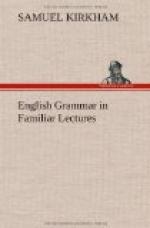6. Where two things are compared or contrasted with each other, a resemblance in the language and construction should be observed.
* * * * *
FIGURES OF SPEECH.
Figures of Speech may be described as that language which is prompted either by the imagination, or by the passions. They generally imply some departure from simplicity of expression; and exhibit ideas in a manner more vivid and impressive, than could be done by plain language. Figures have been commonly divided into two great classes; Figures of Words, and Figures of Thought.
Figures of Words are called Tropes, and consist in a word’s being employed to signify something that is different from its original meaning; so that by altering the word, we destroy the figure.
When we say of a person, that he has a fine taste in wines, the word taste is used in its common, literal sense; but when we say, he has a fine taste for painting, poetry, or music, we use the word figuratively. “A good man enjoys comfort in the midst of adversity,” is simple language; but when it is said, “To the upright there ariseth light in darkness,” the same sentiment is expressed in a figurative style, light is put in the place of comfort, and darkness is used to suggest the idea of adversity.
The following are the most important figures:
1. A METAPHOR is founded on the resemblance which one object bears to another; or, it is a comparison in an abridged form.
When I say of some great minister, “That he upholds the state like a pillar which supports the weight of a whole edifice,” I fairly make a comparison; but when I say of such a minister, “That he is the pillar of the state,” the word pillar becomes a metaphor. In the latter construction, the comparison between the minister and a pillar, is made in the mind; but it is expressed without any of the words that denote comparison.
Metaphors abound in all writings. In the scriptures they may be found in vast variety. Thus, our blessed Lord is called a vine, a lamb, a lion, &c.; and men, according to their different dispositions, are styled wolves, sheep, dogs, serpents, vipers, &c.
Washington Irving, in speaking of the degraded state of the American Aborigines who linger on the borders of the “white settlements,” employs the following beautiful metaphor: “The proud pillar of their independence has been shaken down, and the whole moral fabric lies in ruins.”
2. AN ALLEGORY may be regarded as a metaphor continued; or it is several metaphors so connected together in sense, as frequently to form a kind of parable or fable. It differs from a single metaphor, in the same manner that a cluster on the vine differs from a single grape.
The following is a fine example of an allegory, taken from the 60th psalm; wherein the people of Israel are represented under the image of a vine. “Thou hast brought a vine out of Egypt: thou hast cast out the heathen and planted it. Thou preparedst room before it; and didst cause it to take deep root, and it filled the land. The hills were covered with the shadow of it, and the boughs thereof were like the goodly cedars. She sent out her boughs into the sea, and her branches into the river.”




